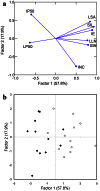Variability in aggressiveness of rice blast (Magnaporthe oryzae) isolates originating from rice leaves and necks: a case of pathogen specialization?
- PMID: 23776629
- PMCID: PMC3679021
- DOI: 10.1371/journal.pone.0066180
Variability in aggressiveness of rice blast (Magnaporthe oryzae) isolates originating from rice leaves and necks: a case of pathogen specialization?
Abstract
Rice blast, caused by Magnaporthe oryzae, causes yield losses associated with injuries on leaves and necks, the latter being in general far more important than the former. Many questions remain on the relationships between leaf and neck blast, including questions related to the population biology of the pathogen. Our objective was to test the hypothesis of adaptation of M. oryzae isolates to the type of organ they infect. To that aim, the components of aggressiveness of isolates originating from leaves and necks were measured. Infection efficiency, latent period, sporulation intensity, and lesion size were measured on both leaves and necks. Univariate and multivariate analyses indicated that isolates originating from leaves were less aggressive than isolates originating from necks, when aggressiveness components were measured on leaves as well as on necks, indicating that there is no specialization within the pathogen population with respect to the type of organ infected. This result suggests that the more aggressive isolates involved in epidemics on leaves during the vegetative stage of the crop cycle have a higher probability to infect necks, and that a population shift may occur during disease transmission from leaves to necks. Implications for disease management are discussed.
Conflict of interest statement
Figures



References
-
- Savary S, Delbac L, Rochas A, Taisant G, Willocquet L (2009) Analysis of non linear relationships in dual epidemics, and its application to the management of grapevine downy and powdery mildews. Phytopathology 99: 930–942. - PubMed
-
- Couch BC, Kohn LM (2002) A multilocus gene genealogy concordant with host preference indicates segregation of a new species, Magnaporthe oryzae, from M. grisea . Mycologia 94: 683–693. - PubMed
-
- Ou SH (1987) Rice diseases, second ed. Farnham House, UK: CAB International. 380 p.
-
- Pinnschmidt HO, Teng PS, Yong L (1994) Methodology for quantifying rice yield effects of blast. In: Zeigler RS, Leong SA, Teng PS, editors. Rice blast disease. Wallingford: CABI and IRRI: Los Baños. 381–408.
-
- Bonman JM, Estrada BA, Bandong JM (1989) Leaf and neck blast resistance in tropical lowland rice cultivars. Plant Dis 73: 388–390.
Publication types
MeSH terms
LinkOut - more resources
Full Text Sources
Other Literature Sources
Research Materials

